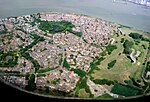Crossness
Areas of LondonDistricts of London on the River ThamesDistricts of the London Borough of BexleyUse British English from August 2015

Crossness is a location in the London Borough of Bexley, close to the southern bank of the River Thames, to the east of Thamesmead, west of Belvedere and north-west of Erith. The place takes its name from Cross Ness, a specific promontory on the southern bank of the River Thames. In maritime terms, the tip of Cross Ness, in the past referred to as 'Leather Bottle Point', marks the boundary between Barking Reach and Halfway Reach. An unmanned lighthouse on Crossness is a navigational aid to shipping.
Excerpt from the Wikipedia article Crossness (License: CC BY-SA 3.0, Authors, Images).Crossness
Bazalgette Way, London
Geographical coordinates (GPS) Address Nearby Places Show on map
Geographical coordinates (GPS)
| Latitude | Longitude |
|---|---|
| N 51.508288 ° | E 0.138295 ° |
Address
Crossness Sewage Treatment Works
Bazalgette Way
SE2 9AR London (London Borough of Bexley)
England, United Kingdom
Open on Google Maps








